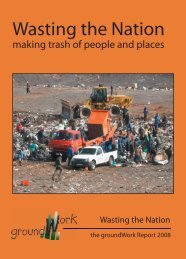Waste Incineration: A Dying Technology - GAIA
Waste Incineration: A Dying Technology - GAIA
Waste Incineration: A Dying Technology - GAIA
Create successful ePaper yourself
Turn your PDF publications into a flip-book with our unique Google optimized e-Paper software.
haphazardly waste resources and then destroy the evidence. Some of the the most dramatic<br />
successes in waste and toxics reduction have been brought about by reducing avenues for easy<br />
disposal of hazardous wastes.<br />
Municipal waste incineration<br />
depends on a waste stream with high<br />
calorific value; that is, one rich in plastics<br />
and wood products (including paper). This<br />
sort of waste stream is the hallmark of the<br />
unsustainable lifestyle being championed<br />
by multinational corporations; and<br />
incinerators are being considered for Southern countries in precisely those pockets, such as<br />
tourist facilities, where this lifestyle has made significant inroads. The Northern lifestyle and its<br />
attendant consumer habits are neither economically achievable nor environmentally sustainable<br />
for the majority of the inhabitants of the planet. By facilitating the destruction of plastic and<br />
paper waste, incinerators encourage the push to produce disposable luxury goods for a small<br />
percentage of the population at the expense of basic necessities for the majority.<br />
Incinerators and Environmental Justice<br />
Incinerators are a problem wherever they may be located, but those who live closest to the<br />
burner are usually the ones who suffer the most. They suffer from the air emissions; from “fugitive”<br />
ashes and emissions; from the increased truck traffic to and from the incinerator; from decreased<br />
property values; and they run the greatest risks in the event of a fire or fly ash spill. Not<br />
surprisingly, politically weak communities are the ones who usually pay this price. As with<br />
other environmentally noxious facilities, incinerators are disproportionately sited in<br />
communities that are poor and belong to racial or ethnic minorities. In 1997, 15 percent of the<br />
United States’ non-white population lived within 2 miles of a permitted medical waste incinerator,<br />
while only 9 percent of the white population did. 110<br />
It is no mere coincidence, nor the “invisible hand” of the marketplace, that places<br />
incinerators in minority and low-income neighborhoods. The pattern of discriminatory facility<br />
siting was originally documented in a 1987 report, Toxic <strong>Waste</strong>s and Race in the United States. 111<br />
In that same year, a consultants’ report prepared for the state of California came to public<br />
attention. That report (written in 1984), “Political Difficulties Facing <strong>Waste</strong>-to-Energy Conversion<br />
Plant Siting,” 112 was a how-to guide for state officials looking for politically vulnerable<br />
communities in which to place incinerators. “All socioeconomic groupings tend to resent the<br />
nearby siting of major (waste disposal) facilities, but the middle and upper socioeconomic<br />
strata possess better resources to effectuate their opposition,” the report says. “Middle and<br />
higher socioeconomic strata neighborhoods should not fall at least within (five miles) of the<br />
proposed site.” The report recommended that incinerators be sited in communities that were<br />
rural, conservative, above middle age, Catholic, and poorly educated. The US$183,000 report<br />
indicated that such populations would be least likely to effectively resist an incinerator. 113<br />
34 <strong>Waste</strong> <strong>Incineration</strong>: A <strong>Dying</strong> <strong>Technology</strong><br />
“<strong>Waste</strong> is the visible face of<br />
inefficiency. Landfills bury the<br />
evidence and incinerators burn it.”<br />
— Dr. Paul Connett<br />
“If everyone lived like the average American, we would need 5.3 planets<br />
to support us,”<br />
--Michel Gelobter, Executive Director of Redefining Progress. 109

















